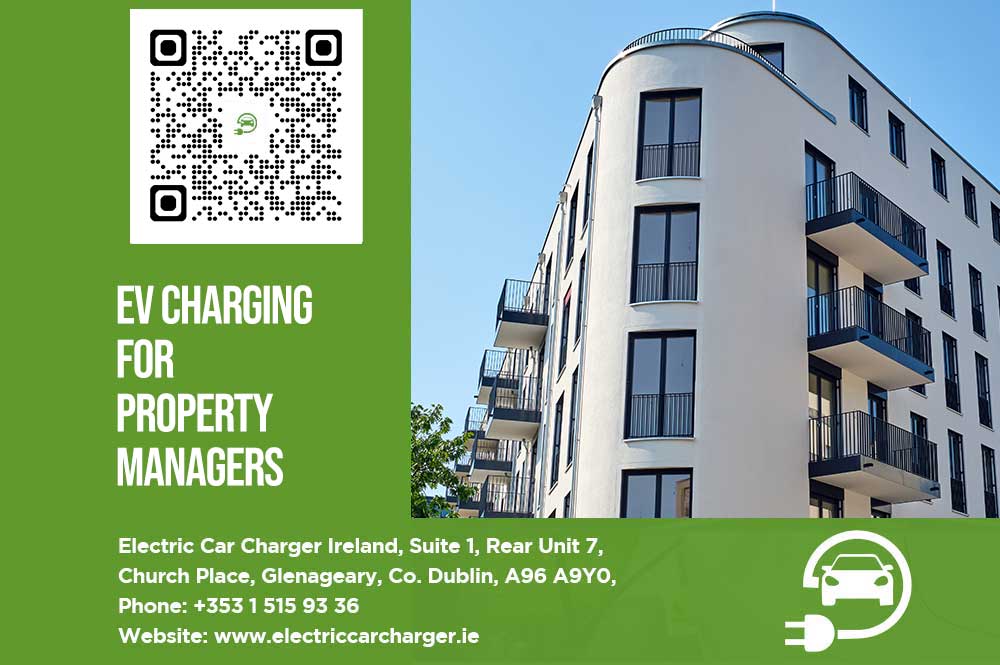Table of Contents
- The Rise of EVs and Charging Demand
- Challenges for Property Managers
- Types of EV Charging Solutions
- Key Installation Considerations
- EV Charging Grants and Incentives
- EV Charging Management Platforms
- Installing EV Charging: Step-By-Step
- Offering EV Charging Long-Term
Electric vehicle adoption is picking up pace, and property managers who are thinking ahead need to gear up for the EV charging needs of their tenants and residents. EV charging stations have become a must-have in order to attract and keep tenants in a competitive market. Deploying large-scale and intelligent EV charging infrastructure is a challenge for property management companies with large residential and commercial real estate portfolios, but it is also an opportunity.
In this guide will take property managers through the essential steps and things to consider when installing and running EV charging in apartment buildings, office parks, and other managed properties.
The Rise of EVs and Charging Demand
The number of electric vehicle sales in Ireland continues to rise gradually. The Republic of Ireland now has more than 1,500 public charging points, which supports the expansion of the electric vehicle fleet. The current number of electric vehicles operating on roads has exceeded 135,900 and projections indicate that this figure will approach one million by 2030. The growing number of EV owners expect easy access to charging facilities both at home and in public areas. The absence of charging infrastructure stands as a major issue for EV drivers while preventing more people from adopting electric vehicles.
Surveys show that over 80% of prospective tenants consider EV charging accessibility as a key factor when deciding on rentals. Therefore, offering charging stations can be considered as a way of gaining a competitive advantage in the market to attract and retain good tenants.
Challenges for Property Managers
There are various issues associated with the implementation of EV charging infrastructure such as:
- Costs: The costs of purchasing and installing charging stations are relatively high in the beginning.
- Electrical Infrastructure: The electrical demands of EV charging may require additional electrical infrastructure, including modifications to the electrical panel to support the load.
- Location: Identifying the right locations for chargers in the parking space of the properties where there is limited parking space.
- Payment Structures: Designing proper payment structures and ways of recovering costs from the users.
- Scalability: Picking solutions that can easily expand with growing demand.
For large portfolios, property managers have to balance the need to meet the current needs of the tenants with the need to pick systems that will be able to expand. Without smart technologies, the management of usage, access control, maintenance, and costs can also be a chore in the future.

Types of EV Charging Solutions
The following are some of the EV charging solutions that property managers can offer:
- Individual Wall Chargers: A simple EV wall charger can be fitted outside each unit’s parking bay to give the resident a level 1 or 2 charger. Tenants bear the costs of charging their EVs. Although it is the simplest, this can be costly to install for every stall.
- Shared Charging Stations: Central shared charging hubs enable several EVs to charge at once on a first come first served basis. Stations can have multiple charge points to serve more vehicles. The costs are borne by the users.
- Smart Networked Charging: Advanced EV charging networks have management software that manages the charging processes on the basis of demand, manages access through apps or RFID cards, and charges the users for the usage. Networked smart chargers are the most efficient, flexible, and functional.
Key Installation Considerations
When installing EV charging infrastructure, property managers need to evaluate:
- Total Costs: The total cost of the purchase of charging equipment and electrical work.
- Power Requirements: Power requirements and electrical panel capacity – it may be necessary to upgrade.
- Charger Placement: Where to put the chargers to be easily accessible and easily reached.
- Parking Layouts: Spaces that will not block the general parking space and parking layouts and locations.
- Mounting Options: Mounting options, bollards, and protective barriers.
- Ongoing Fees: Ongoing software fees and connectivity requirements.
EV Charging Grants and Incentives
There are several incentives available to help offset the costs of installing EV chargers:
- SEAI EV Charging Infrastructure Grant: If you are a Management Company and would like to install an EV charger network in to your development, the Apartment Charger grant scheme will offer you grant support towards the installation of the charging network, cabling, electrical connection, communications systems and EV charging units.
- Accelerated Capital Allowance Scheme: Tax break for energy-saving equipment.
- SEAI Better Energy Communities: Grants for community-initiated projects.
- Local Council EV Supports: Some provide extra grants and funding.
Using the available grants and tax incentives can help make installing chargers more affordable and feasible.
EV Charging Management Platforms
In order to optimise the use of chargers and charging correctly, an EV charging management platform is advised to be used. Some of the features to consider when choosing include:
- App/RFID-based Access Control
- Usage Tracking: By user and vehicle
- Load Balancing: Charge scheduling optimisation
- Flexible Pricing: Billing options
- Real-time Monitoring: Analytics dashboard
Electric Car Charger Ireland serves as a complete solution for handling large-scale network EV charging management.
Installing EV Charging: Step-By-Step
Your successful property-based EV charging deployment requires these essential steps:
- Survey Residents/Tenants: Assess needs and demand
- Calculate Electrical Capacity: Plan any required upgrades
- Select Charger Types: Choose appropriate charger types and quantities
- Apply for Grants: Where eligible
- Procure Equipment: Choose and procure charging station equipment
- Installation: Hire a licensed EV charger electrician to install and connect chargers
- Setup Management Software: Set up management software and billing procedures
- Promote Availability: Promote the availability of EV charging to tenants and residents
- Ongoing Maintenance: Provide ongoing maintenance and support as needed
Offering Long-Term EV Charging
The installation of basic chargers represents only the initial step. A sustainable EV charging program requires proactive steps that deliver positive experiences to users:
- Engage Tenants: Regularly engage tenants about EV charging options while seeking their feedback about station placement.
- Staff Training: Staff training, along with user guides for charger operation and billing procedures, should be provided.
- Gather Feedback: Gather feedback to improve the charging experience.
- Utilisation Data: The evaluation of utilisation data should trigger periodic additions of new chargers to satisfy demand.
- Stay Informed: Stay informed on emerging EV technology advancements and standards – Home Charger for Electric Cars installers.
Real estate properties that provide sufficient EV charging facilities will emerge victorious in the market of growing EV adoption. The installation of EV charging benefits property managers who follow this roadmap to enhance their managed real estate portfolios and resident experience.
Ever wondered about Electric Car Charging Points Ireland?…..Check out our latest blog post for details.



